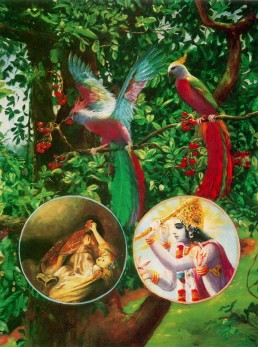Swami Chinmayananda
Swami Chinmayananda Commentary
OF RUDRAS I AM SHANKARA — The concept of Rudra, as the deity of destruction, is to be recognised by every student of life because destruction is a necessary precedent to every subsequent construction. The flower must die to yield its place to the fruit. The fruit must perish for the seeds to come out. The seeds must rot to bring forth the seedling. Thus, in every progress there is a continuous stream of constructive destruction. This is recognised by the subtlest thinkers that were ever born among men, the Rishis, and in their full understanding they fearlessly respected and adored the blessed deity of creative destruction — ShankaraI AM THE TREASURER OF WEALTH (KUBERA) AMONG THE YAKSHAS AND RAKSHASAS — The Chancellor of the Exchequer in heaven is described in the Puranas as Kubera, a monstrous, ugly creature, three-footed, fat and short, with a spreading belly, a small head and eight protruding teeth. The divine cashier is helped by Yakshas and Rakshasas — an equally ugly, materialistic, heartless brood — in protecting his treasures. It is interesting to note how the Indian Rishis were typically against capitalism and how they cartooned the master-of-wealth in such a grotesque caricature, so ugly that
it cannot bring about even an indulgent smile to our lips.
OF THE VASUS, I AM PAVAKA — There are eight Vasus and they are Vedic deities presiding over the seasons. In Chandogya Upanishad it is described that the MOUTH of these Vasus is fire; there, the word “mouth” may be conceived of as the instrument of enjoyment and experience. Therefore, it means that the Self is the very source from which we gain all our experiences of all seasons.
The six seasons which the world outside gives us, and the two seasons which the mind supplies us with, viz., joy and sorrow, together constitute the eight seasons mentioned here. Even the spring-time flowers will shed tears for us, if, at that time, we are in tragic bereavement, while even the naked trees of the autumn season will be quivering with joy for us, if, in that season, we have the joy of success, full and complete — thereby the two internal seasons. All of them are experienced by us only when we are under the grace of our own Consciousness within.
OF ALL THE PEAKS I AM MERU — A mythological mountain, believed to be the centre of the Universe, according to ancient Hindu Geography, is Meru. On top of it, lives the Divine, and below it, lie scattered the Seven Islands that constitute the world. Meru is conceived as having an altitude of seven to eight thousand miles and it is described that from its top, the Ganges flows in all directions. This statement has made many believe that it may be the Himalayas — which is not, of course, very unsatisfactory. But we would rather believe it to be a mystical phraseology — representing some special “field of influence,” having its base in Jambu-dweepa and its extent rising up to the peak described above, from where Spiritual Knowledge flows out on all the four sides to bless all of the islands.
CONTINUING TO INDICATE THE STATUS OF THE SELF AMONG THE THINGS OF THE KNOWN WORLD:
Adi Sankara Commentary
Rudranam, among the eleven Rudras, I am Sankara; and yaksaraksasam, among the Yaksas and goblins; I am vittesah, Kubera. Vasunam, among the eight Vasus; I am pavakah, Fire; and sikharinam, among the peaked mountains, I am Meru.
The Bhagavad Gita with the commentary of Sri Sankaracharya – Translated by Alladi Mahadeva Sastry
Holy Geeta – Commentary by Swami Chinmayananda
The Bhagavad Gita by Eknath Easwaran – Best selling translation of the Bhagavad Gita
The Bhagavad Gita – Translation and Commentary by Swami Sivananda
Bhagavad Gita – Translation and Commentary by Bhaktivedanta Swami Prabupadha
Srimad Bhagavad Gita Chapter 10 – Verse 23 – 10.23 rudranam sankarascasmi – All Bhagavad Gita (Geeta) Verses in Sanskrit, English, Transliteration, Word Meaning, Translation, Audio, Shankara Bhashya, Adi Sankaracharya Commentary and Links to Videos by Swami Chinmayananda and others – 10-23

